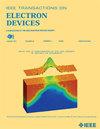Robustness Analysis of 1200-V IGBT Under Extremely High-Gate Voltage Stress
IF 2.9
2区 工程技术
Q2 ENGINEERING, ELECTRICAL & ELECTRONIC
引用次数: 0
Abstract
In this study, the robustness of insulated gate bipolar transistors (IGBTs) under extreme high-gate voltage stress (both positive and negative) is comprehensively investigated. The results indicate that all IGBTs maintain essential electrical characteristics, demonstrating considerable robustness to extreme gate voltage stress. However, varying degrees of degradation are observed depending on the polarity of the applied stress. Specifically, under high-positive gate voltage stress, the threshold voltage remains nearly stable, whereas under high-negative gate voltage stress, a significant increase in the threshold voltage is noted. Based on these findings, the degradation mechanism is proposed and experimentally validated. For negative gate voltage stress, degradation primarily results from electron injection from the gate, with elevated temperatures accelerating this process. In contrast, under positive gate voltage stress, the hole injection efficiency is much lower than that of electrons, and part of the gate voltage is absorbed by the depletion region. Additionally, G–V measurement, C–V measurement, and simulation are conducted to support the proposed mechanism. This work contributes to a deeper understanding of IGBT degradation mechanisms under high-gate voltage stress, offering insights relevant for their application in high-stress operational environments.求助全文
约1分钟内获得全文
求助全文
来源期刊

IEEE Transactions on Electron Devices
工程技术-工程:电子与电气
CiteScore
5.80
自引率
16.10%
发文量
937
审稿时长
3.8 months
期刊介绍:
IEEE Transactions on Electron Devices publishes original and significant contributions relating to the theory, modeling, design, performance and reliability of electron and ion integrated circuit devices and interconnects, involving insulators, metals, organic materials, micro-plasmas, semiconductors, quantum-effect structures, vacuum devices, and emerging materials with applications in bioelectronics, biomedical electronics, computation, communications, displays, microelectromechanics, imaging, micro-actuators, nanoelectronics, optoelectronics, photovoltaics, power ICs and micro-sensors. Tutorial and review papers on these subjects are also published and occasional special issues appear to present a collection of papers which treat particular areas in more depth and breadth.
 求助内容:
求助内容: 应助结果提醒方式:
应助结果提醒方式:


